Frequently Asked Questions about Good Habits and BrightWorks Oral Care Products
While BrightWorks makes maintaining good dental health accessible and affordable, choosing the right products and establishing a good oral care routine takes some effort. We’ve compiled these frequently asked questions about BrightWorks Oral Care Products and developing good oral care habits to help you and your family ensure a lifetime of bright, healthy smiles.
GENERAL ORAL HEALTH AND BEST PRACTICES
I always get good dental checkups and never get cavities, even though I rarely floss. So why do I still need to clean between my teeth?
Using dental floss or another interdental cleaner every day to clean between your teeth is important for helping to remove food debris and plaque that can lead to cavities. Flossing, however, is also essential for maintaining healthy gums. According to the American Dental Association (ADA), “Dental floss and other interdental cleaners help clean these hard-to-reach tooth surfaces and reduce the likelihood of gum disease and tooth decay.” Periodontal disease (or gum disease), if not treated early, can lead to receding gums and tooth loss, and become a serious problem.
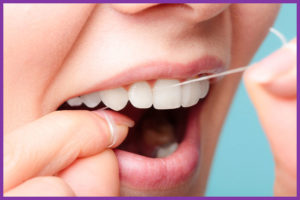
Getting my children to brush their teeth is always a chore. What can I do to prevent this from being a fight every night?
There are a multitude of approaches you can take with your children, since there is no one simple solution. You can try brushing your teeth with your children at the same time. Letting your child choose their toothbrush and toothpaste, or helping them do so, allows them to brush with products that are more enjoyable and fun. You might find that fun characters, flavors, or animals are good incentives getting children to brush. If your child loves a particular two-minute song, consider singing it or playing it as your child brushes along to it. Look for ways to turn brushing into a game, or consider building a reward system that aids both you and your child.
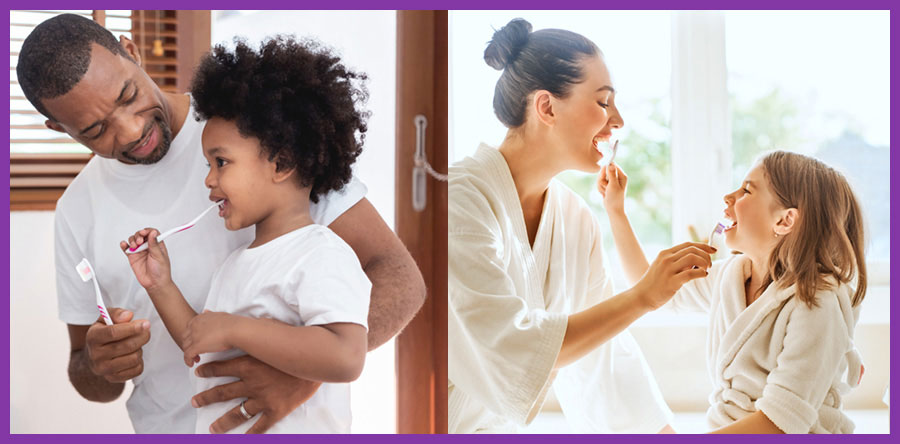
What is the best way for me to take care of my oral health when I’m away from home?
Brushing and cleaning between your teeth is always important after meals, but are not always easy or convenient. Strongly consider using a small, foldable travel toothbrush (that is easy to transport and discrete) whenever possible to maintain a brushing routine. Think about using a flosser, dental pick, or interdental brush if you are unable to floss when away from home, since they be used easily outside of the bathroom.

What causes bad breath?
Bad breath, sometimes called halitosis, can be caused by a variety of things. Most, but not all, causes of bad breath reside in your mouth. Bad breath is commonly caused by food, either as it breaks down in your mouth, or from specific ingredients, such as garlic and onions. Another cause can be inadequate dental hygiene, as leftover food particles in your mouth can create bacteria-producing odors. Smoking, dry mouth, infections, medications, or certain diseases can also be a source of bad breath.
How can I prevent bad breath?
Consult your dentist if you’re finding it difficult to keep your breath fresh. Your dentist may refer you to your primary care doctor if it is caused by an underlying health condition. However, good oral hygiene can typically prevent halitosis. Brushing and cleaning between your teeth just after eating to remove food and debris is always important. Using a mouthwash (particularly one that kills bacteria) is also something to consider. Using a tongue cleaner or brushing your tongue to reduce odor-causing bacteria that can build up on your tongue or cheeks can be helpful, too. You may need to consider changes to your diet, if needed.

What causes my teeth to get stained?
Stains can be on the surface of your teeth or even below the surface. Certain types of food and drink, such as sodas, coffee and red wine; tobacco (smoking or chewing); poor oral hygiene; or certain diseases, are some of the many causes of stained teeth.
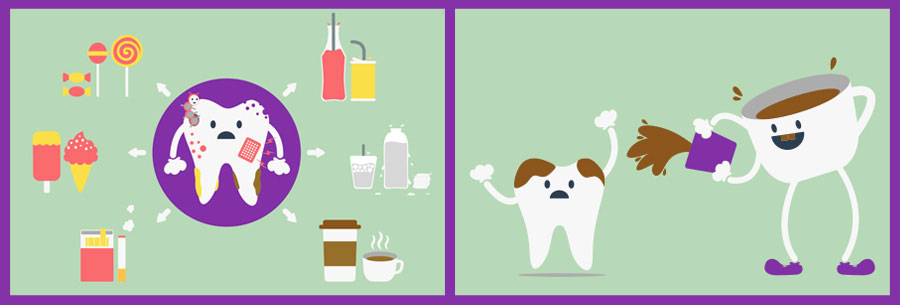
What can I do to help make my teeth whiter?
There are some simple steps you can take to help remove surface stains and make your teeth whiter. Begin by using a whitening toothbrush and toothpaste. Whitening mouthwashes are also available to help remove stains. Flossing or using other types of interdental cleaning products, like dental picks, flossers, and interdental brushes, can help remove stains between your teeth. Consider using tooth whitening strips for stains below the surface of your teeth. It might be helpful to weigh all of your options by consulting with your dentist.

INTERDENTAL CLEANING
What is the best product to use to clean between my teeth?
A wide range of BrightWorks products are available for cleaning between your teeth, including flossers, dental floss and picks, and interdental brushes. Food and plaque can be effectively removed from between your teeth by using each of these products. It may be easier to use products like flossers, dental picks, and interdental brushes if you have dexterity challenges using string floss. Some products are designed to be used away from home, if that is important to you. Cleaning between your teeth every day is most important. Consult with your dental professional if you have questions about which product might be best for you.
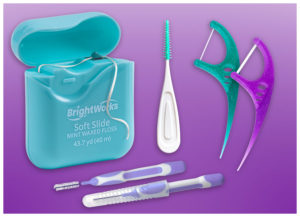
What makes BrightWorks dental picks soft and comfortable?
Specifically designed with special rubber bristles, BrightWorks dental picks are extra-gentle in use. The soft rubber is considered more comfortable by many people, compared to wood and plastic dental picks, and other product types for cleaning between your teeth.
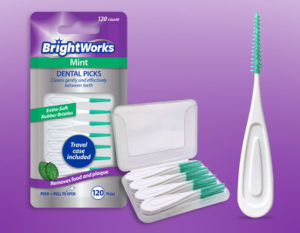
Why is flossing important?
To help maintain good oral health, it’s important to remove bacteria-containing plaque that feeds on food debris and sugar in your mouth. However, a toothbrush simply cannot reach every part of your mouth. You can help prevent cavities and gum disease by cleaning between your teeth every day.

How often should I floss?
The American Dental Association recommends that you clean between your teeth daily with an interdental cleaner, such as dental floss. This helps ensure that you get food debris out of hard-to-reach places after meals.

What are the differences between the types of floss?
There are two basic types of floss offered by BrightWorks. Made from soft, highly slippery material, BrightWorks Soft Slide Floss is best for those with tight spaces between their teeth or sensitive gums. BrightWorks Mint Waxed, Waxed, and Mint Charcoal Flosses are designed to help remove stains between teeth and features a twisted nylon that is great for deep cleaning.
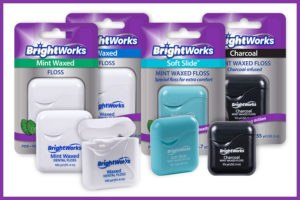
How old does someone have to be to use BrightWorks Flossers?
Adult supervision is required for children under the age of 10 while using a flosser. Flossers are not intended to be used by children under the age of 4. However, use of a kids’ flosser can help to build healthy oral care habits for life for children 4 years and older.
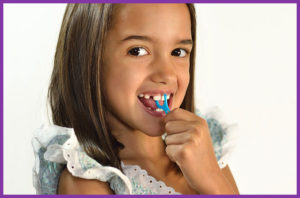
Which flosser is the right one for me?
Several different flossers are offered by BrightWorks to meet specific needs. Designed to be fun and easy to use, our kids’ flossers are grape-flavored to help children develop healthy oral care habits. BrightWorks Soft Slide Flossers have a special floss that slides more easily between tight teeth and can be more comfortable to use for people with sensitive gums or very tight teeth. BrightWorks Fresh Mint + Whitening Flossers (with fresh mint flavor and micro-crystals) are a great option for people with more typical spaces between teeth.
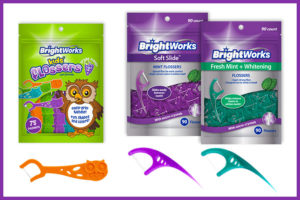
Do BrightWorks flossers have fluoride?
Only BrightWorks Kids’ Flossers contain fluoride.
What is the right technique for flossing my teeth?
Begin with an 18-inch piece of dental floss and wrap it around your fingers. Gently slide the dental floss in between your teeth and use a gentle back-and-forth and up-and-down movement along each tooth to floss. The back-and-forth motion helps clean away plaque and food debris from between your teeth and gums.
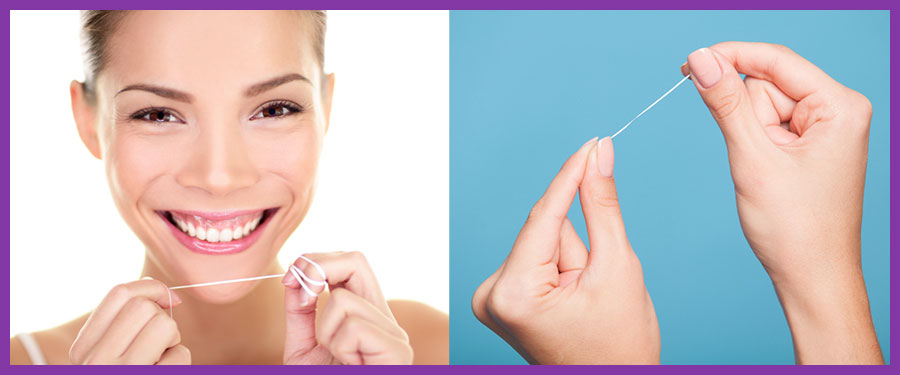
How do I use a flosser?
While holding the flosser between your fingers, gently slide it between your teeth. Rub the floss gently up and down along each tooth and rinse the floss, as needed. Be sure to dispose of the flosser after use.
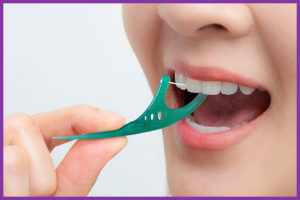
Can I use individual flossers multiple times?
Although they are made with extremely durable materials and designed to complete a whole-mouth cleaning, BrightWorks Flossers should be disposed of after each use. You should use a new flosser every time you floss.
BRUSHING TEETH
How do I select the right toothbrush for me?
Choosing a toothbrush can be very confusing, considering how many options there are in the market. Many toothbrushes are designed to address a specific, individual need:
- For a good overall clean, choose a toothbrush with a simple bristle configuration and soft bristles.
- For extra help keeping your teeth white, choose a brush that is designed specifically for whitening, such as the BrightWorks Whitening toothbrush.
- A toothbrush with extra-tapered bristles to help clean under the gum line should be used by anyone concerned about gum health.
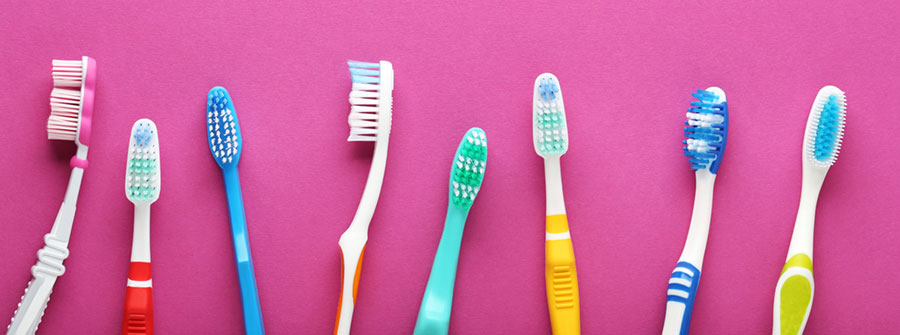
Should I use a manual or electric toothbrush?
No matter what you choose, brushing twice per day for two minutes each time with a proper brushing technique is important. Dentist Richard Price of the American Dental Association notes that, “All things being equal, an electric brush or a hand brush will do the same good job. You see, it’s not the brush, it’s the brusher.” Ultimately, the decision to use an electric or manual toothbrush might be based on personal preference or, in some cases, a dental professional’s specific recommendation.
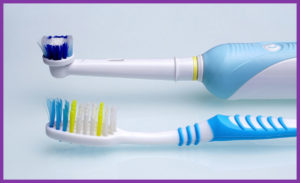
What is the correct technique to brush my teeth?
Using your toothbrush at a 45-degree angle to your gums is correct way to brush your teeth, according to the American Dental Association. Gently brush back and forth in short strokes with your toothbrush at that angle to your gums. Be mindful of brushing every surface of your teeth, including inner, outer, and chewing surfaces. To brush the surfaces on the backside of your front teeth, use an up-and-down motion while tilting the toothbrush vertically.
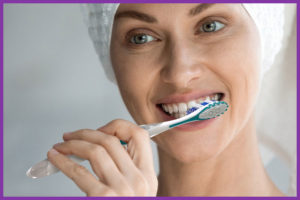
What are extremely tapered bristles?
Since they are thinner at the top of the bristle than they are at the base where they attach to the brush head, tapered or extremely tapered bristles can be more effective at cleaning hard-to-reach places, such as under the gum line or between your teeth.
How often should I replace my toothbrush?
According to the American Dental Association, you should change your toothbrush every 3 to 4 months. Your toothbrush should also be replaced if you notice that the bristles are fraying prior to 3 to 4 months of use. BrightWorks Whitening Toothbrushes feature colored reminder bristles to help prompt you when it’s time to replace your brush.
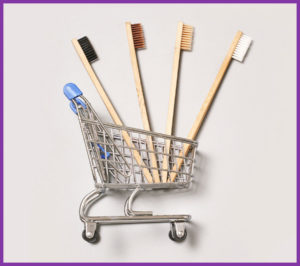
What are oral health best practices for adults?
There are several key components to achieving good oral health for adults, according to the Center for Disease Control website. These include, but are not limited to, brushing teeth twice per day with a fluoride toothpaste, flossing every day to remove dental plaque, drinking fluoridated water, and visiting your dentist once per year or more.

Why do my gums bleed when flossing?
Flossing helps to remove plaque buildup before it hardens into tartar, and is a critical part of a healthy oral care routine. However, your gumline can become inflamed and irritated if you do not floss regularly. When tartar, plaque, and bacteria collect along your gumline, your gums may start to appear unhealthy and there may be some bleeding while flossing. Periodontal disease, certain medical conditions, hormonal changes, or incorrectly flossing are among the variety of different reasons why bleeding might occur.
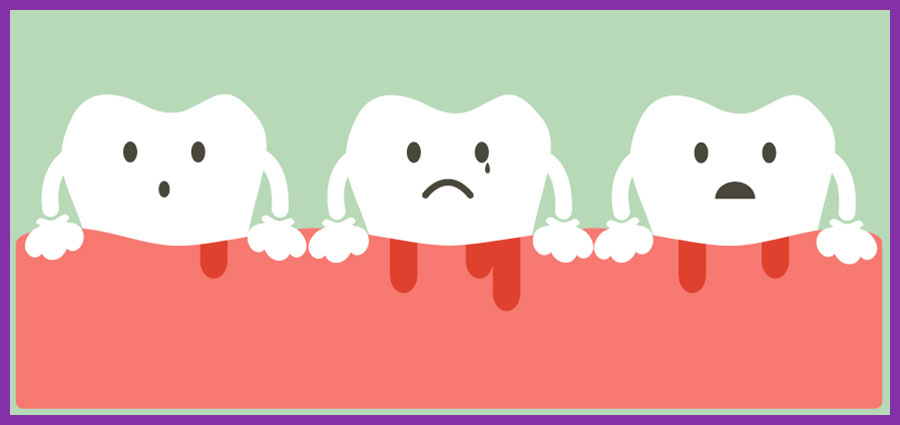
How often should I brush my teeth and for how long?
It is generally recommended that people brush their teeth twice per day, two minutes each time.
How can I prevent tooth decay in my child’s teeth?
Building healthy habits early is the best way for children to prevent tooth decay. According to the Centers for Disease Control, children should drink tap water containing fluoride and brush their teeth twice per day. You may also want to consider asking your dentist if it is appropriate to apply a fluoride sealant.
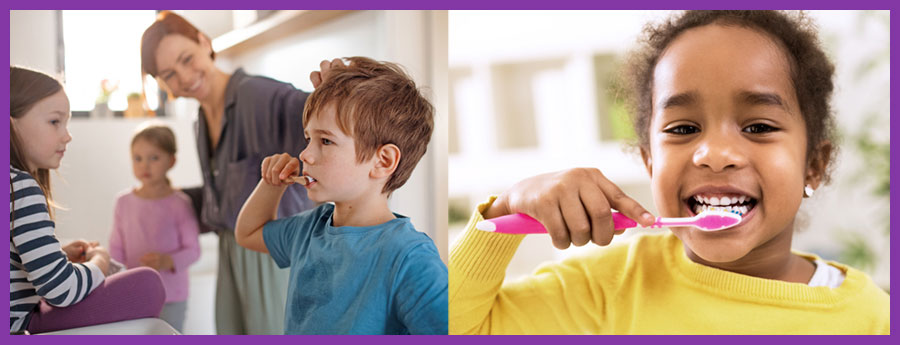
How can I help my kids create good oral care routines?
Getting children to develop a good oral health routine is rarely easy and can be particularly challenging at bedtime. At an early age, it’s vital to help them understand how important good oral care is to overall health and wellness. Start dental care early, even before your child’s first teeth come in. To help familiarize your child with the cleaning, begin by simply wiping their gums gently. Start gently brushing their teeth with a little toothbrush once their teeth begin to appear. It can also be beneficial to have children watch you brush so they can see a healthy example to emulate. You should also explain why dental care is important and a vital part of a good daily routine. Adding fun to an oral care routine can help, as well. Help your child choose toothbrushes that are fun to use, have music, interesting colors, or characters. A fun-flavored toothpaste can also help to turn brushing into a better experience. Beyond brushing and flossing, it’s important to teach your kids how healthy foods and drinks can help maintain good dental health.

When should flossing begin for children?
The time to introduce flossing as part of a healthy, regular routine is when your child has two teeth that touch each other. You should floss your child’s teeth once per day, which should take about 2 minutes. Use an 18-inch piece of floss secured by either wrapping it around your middle fingers or holding it tightly between your index fingers and thumbs. Move the floss up and down around every tooth surface while making sure to get below the gumline. For best results, the floss should be shaped into a “C” so that it can better reach all surface areas of each tooth. Discard the floss away once completed.
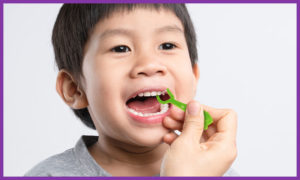
Consumer Resources
BrightWorks believes that educating yourself about proper oral health is an integral part of maintaining overall wellness. And the experts agree. We invite you to visit these informative websites to learn more.*
Basics of Oral Health
From the Centers for Disease Control and Prevention
Oral health affects our ability to eat, speak, smile, and show emotions. Oral health also affects a person’s self-esteem, school performance, and attendance at work or school. Oral diseases—which range from cavities and gum disease to oral cancer—cause pain and disability for millions of Americans and cost taxpayers billions of dollars each year.
Oral Health Foundation
Better Oral Health for All
The Oral Health Foundation is an independent charity (not for profit) dedicated to improving oral health and well-being around the world. For more than 45 years we have continued to provide expert, independent and impartial advice on all aspects of oral health directly to those who need it most.
MouthHealthy.org
Brought to you by the American Dental Association
When it comes to understanding oral hygiene, your toothbrush and floss are only the beginning. MouthHealthy helps take the guesswork out of understanding your oral health and has information you need to take better care of your mouth today so it will take care of you for life.
*The links provided above are for informational use only, and do not imply endorsement of BrightWorks or BrightWorks products by any of the organizations cited.
